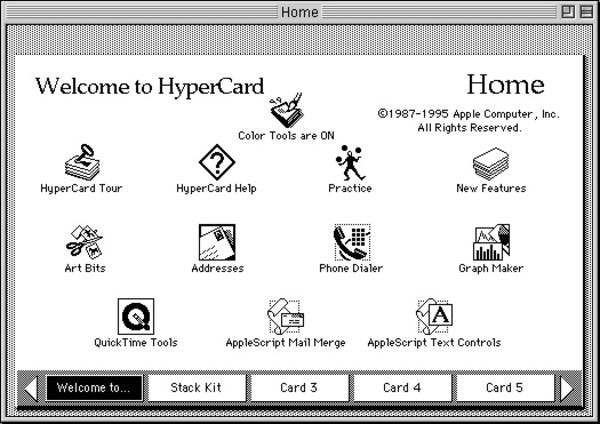We’re witnessing the professional equivalent of a time-lapse bloom.
What took decades with the internet is now happening in quarters (weeks? days?) with AI. These tools aren’t rolling out in neat, predictable cycles. They’re crashing over industries like a tsunami. Like the internet before it, AI isn’t just changing the game. It’s rewriting the rulebook.
When Mastering Tech Was Still a Moat
I was a TA in one of the first Mac Labs in the country at Florida State University circa 1990. We maintained the machines and made interactive books and stories with Hypercard. I fell in love with technology at that exact moment.
In 1993, I sat in the lunchroom at UPS HQ in Atlanta reading Wired Magazine, learning about the World Wide Web (remember when we called it that?). When I built my first website, fewer than 4,000 sites were on the entire web.
Through sheer curiosity and experimentation, I found myself with a new set of skills that most didn’t know existed. At Swan Media, we built a website for a bank and charged them $50,000, which blew our minds.
Since then this pattern has held: learn a new digital tool early, get good at it, and ride it until something more interesting comes along.
From Hypercard to PageMaker and Photoshop, to HTML and FileMaker Pro (Siteman shout-out!) to early social media dashboards, the arc was reliable, and I rode it like Tony Hawk, weaving and bobbing and doing all sorts of tricks. QuickTime VR, E-mail marketing, SecondLife, and so on.
That arc is gone.

The Compressed Timeline of AI Advantage
ChatGPT reached 100 million users in two months. Instagram took two and a half years. The commercial internet itself took 7 years. The telephone? Seventy-five.
The edge gained from AI adoption now arrives faster and disappears just as quickly. This compression doesn’t just reward early adopters; it punishes delay. In compressed cycles, being early isn’t just an advantage, it’s sometimes our only shot at relevance.
Consider the teams that adopted cloud-based collaboration in 2015 versus 2020. Their productivity gap was staggering. But that was a linear shift. A better way to work with familiar tools.
Apply that lag to generative AI, where the capability leap is nonlinear and accelerating. Missing the curve isn’t like being late to Slack. It’s like showing up with a calculator while everyone else has spreadsheets.
This isn’t fax-to-email. It’s calculator-to-Excel. And by the time you’ve caught up, the next tool is already reshaping the game.
Domain Expertise: The Secret Multiplier
The power of AI is compounding at the intersection of tool and context.
MidJourney (or any Generative AI image platform) in the hands of someone trained in photography and lighting? Completely different in the hands of someone without that experience.
It plays out across many (all?) professions:
A marketer with behavioral psychology chops gets more out of AI copywriting
A software architect builds more stable code using AI
A physician with diagnostic expertise uses AI to sharpen their thinking
AI isn’t eliminating expertise. It’s amplifying it.
From Fear to Framework
Most AI conversations are still framed around fear, usually of job loss, Terminators, or Hallucinations (as if humans aren’t error-prone).
But tech revolutions rarely destroy work. They reshape it.
Remember when ATMs were going to kill off bank tellers? Banks didn’t shrink. They expanded. And the teller role evolved from cash handling to relationship-building.
AI isn’t coming for your job. It’s coming for tasks within your job.
The real shift? Professionals who partner with AI will replace those who don’t.
That’s not hype. It’s historical pattern recognition.
The printing press didn’t kill writers. It created publishing. The camera didn’t eliminate art. It birthed photography.
Each time, creative boundaries expanded.
AI+ You: The Evolution Starts Now
This is the your moment.
Treat AI as a threat or adopt it as the most powerful creative and cognitive tool in history.
Professionals who thrive next won’t necessarily be the most credentialed.
They’re the ones who develop “AI+”: the ability to combine expertise with algorithmic leverage.
They’ll know when to defer to AI and when to override it.
And here's the kicker: this skill set doesn’t take years to build.
You don’t need to master code or design.
Don’t believe me? Try my Prompt Architect GPT (free or paid ChatGPT account required) and tell me that it doesn’t immediately improve your prompting skills.
You need curiosity, context, and a few weeks (days? hours?) of deliberate experimentation.
Think “Centaur Chess”
After Deep Blue beat Kasparov, the best chess players didn’t walk away. They teamed up with machines.
“Centaur chess,” that is, human + computer teamwork, consistently beat humans or computers alone.
That’s the future. Not human versus machine.
Human and machine.
Together, we’ll tackle problems that were unsolvable before.
You will use AI.
The question is: Will you help shape how it’s used?
Or play catch-up in a game where the rules have already changed?
The early adopter window isn’t closed. But it is narrowing.
Step through.
P.S. My latest idea is to build a v1 of MarcGPT - a Jarvis-like collection of GPTs, agents, and tools I can use as a personal, digital assistant. I’ve already begun the planning by using Prompt Architect to create a framework, Claude to polish and humanize the narrative, and Cursor to help me flesh out a basic framework. Interested in following the journey? Subscribe and join the fun.
P.S.S. Want to know more about Siteman? Ask me anytime. It’s a hella story. Think Squarespace or Wix decades too early.




